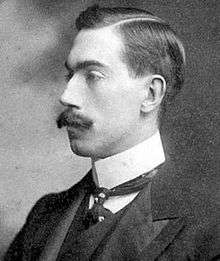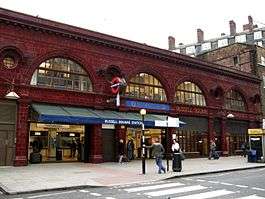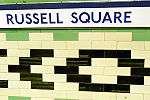Leslie Green
Leslie William Green (6 February 1875 – 31 August 1908)[1] was an English architect. He is best known for his design of iconic stations constructed on the London Underground railway system in central London during the first decade of the 20th century, with distinctive oxblood red tiled façades including pillars and semi-circular first-floor windows, and patterned tiled interiors.
Leslie Green | |
|---|---|
 Leslie Green, c. 1906 | |
| Born | Leslie William Green 6 February 1875 Maida Vale, London |
| Died | August 31, 1908 (aged 33) |
| Occupation | Architect |
Early and private life
Green was born in Maida Vale, London in 1875, the second of four children of architect and Crown Surveyor Arthur Green and his wife Emily.[1] He spent periods studying at Dover College and South Kensington School of Art, and in Paris, between periods working as an assistant in his father's architectural practice.[1][2]
Green married Mildred Ethel Wildy (1879–1960) in Clapham in April 1902. In 1904, they had a daughter, Vera (1904–1995).[1]
Career
Green established his own practice as an architect in 1897, working initially from his father's offices, before moving to Haymarket in 1900 and then to Adelphi House on Adam Street, by the Strand, in 1903. He became an associate of the Royal Institute of British Architects (RIBA) in 1898, and a member in 1899. Early commissions included works to homes and shops in various parts of the capital city.[1][2]
In 1903 he was appointed as architect for the Underground Electric Railways Company of London (UERL) to design stations for three underground railway lines then under construction – the Great Northern, Piccadilly and Brompton Railway (GNP&BR), the Baker Street and Waterloo Railway (BS&WR) and the Charing Cross, Euston and Hampstead Railway (CCE&HR), which, respectively, became parts of the present day Piccadilly line, Bakerloo line and Northern line. Green was commissioned to design 50 new stations, including their external appearance, and internal fittings and decoration.[1][2]


Green developed a uniform Arts and Crafts style for the ground level station buildings, adapted to suit the individual station location. They were constructed as two-storey buildings with a structural steel frame – then a new form of construction recently imported from the United States – providing the large internal spaces needed for ticket halls and lift shafts (the first escalators were introduced in 1911). The exterior elevations were clad in non-loadbearing ox-blood red (sang de boeuf) glazed terracotta (faïence) blocks, provided by the Leeds Fireclay Company. The ground floor was divided into wide bays by columns, allowing separate entrances and exits, and also providing space for retail outlets. The design also featured large semi-circular windows at first floor level (occasionally with circular occuli) and a heavy dentilated cornice above. A broad strip between the two floors announced the name of the station in capital letters. The station buildings were constructed with flat roofs with the deliberate aim of encouraging commercial office development above, another benefit of the load-bearing structural steel frame.[2]
The interior was tiled in green and white, with decorative details. At platform level, the stations were provided with a standardised tiling design incorporating the station name, but with quickly identified individual colour schemes and geometric tile patterns formed in repeating panels along the platform length. Directional signs were also included in the tile designs. The tiled surfaces created a unifying theme, and proved easy to maintain.[2]
The railways were to open in 1906 and 1907, and Green was notified in June 1907 that the contract would be terminated at the end of that year. He was elected a Fellow of the RIBA in 1907, including details of his work for the UERL as part of his submission.[1]
Many of Green's station buildings survive, although internal modifications have seen most of his ticket hall designs altered to suit later developments. At platform levels a number of the original tiling schemes survive today or have, as at Lambeth North and Marylebone, been reproduced in recent years to the original pattern. A number of the surviving buildings are Grade II listed buildings: Aldwych, Belsize Park, Caledonian Road, Chalk Farm, Covent Garden, Gloucester Road, Holloway Road, Oxford Circus, Mornington Crescent, Russell Square and South Kensington.[3] His work was continued by his assistant, Stanley Heaps. The designs remain instantly recognisable: the screen appearance of the fictitious Walford East Underground station from the BBC soap opera EastEnders is inspired by Green's designs.[1]
Leslie Green stations
- For complete lists of central London stations of these lines see Bakerloo line, Piccadilly line and Northern line
|
Bakerloo line
|
Piccadilly line
|
Northern line
|
Death
Green contracted pulmonary tuberculosis[4] and died on August 31, 1908 at a sanatorium in Mundesley-on-Sea, Norfolk.[1][5]
References
- Paterson, Mike (2013). "Green, Leslie William (1875–1908)". Oxford Dictionary of National Biography. Oxford University Press. doi:10.1093/ref:odnb/64597. Retrieved 1 July 2013.(subscription required)
- "Green, Leslie". Exploring 20th Century London. Renaissance/Museums, Libraries and Archives Council. Archived from the original on 6 February 2012. Retrieved 1 March 2010.
-
Historic England. "Aldwych Underground Station (Grade II) (1401034)". National Heritage List for England. Retrieved 31 August 2014.
Historic England. "Belsize Park Underground Station (Grade II) (1401089)". National Heritage List for England. Retrieved 31 August 2014.
Historic England. "Caledonian Road Underground Station (Grade II) (1401086)". National Heritage List for England. Retrieved 31 August 2014.
Historic England. "Chalk Farm Underground Station (Grade II) (1401028)". National Heritage List for England. Retrieved 31 August 2014.
Historic England. "Covent Garden Underground Station (Grade II) (1401025)". National Heritage List for England. Retrieved 31 August 2014.
Historic England. "Gloucester Road Underground station (Grade II) (1080658)". National Heritage List for England. Retrieved 31 August 2014.
Historic England. "Holloway Road Underground station (Grade II) (1195635)". National Heritage List for England. Retrieved 31 August 2014.
Historic England. "Oxford Circus Underground Station (Grade II) (1401022)". National Heritage List for England. Retrieved 31 August 2014.
Historic England. "Mornington Crescent Underground station (Grade II) (1378713)". National Heritage List for England. Retrieved 31 August 2014.
Historic England. "Russell Square Underground Station (Grade II) (1401730)". National Heritage List for England. Retrieved 31 August 2014.
Historic England. "South Kensington Underground station (Grade II) (1392067)". National Heritage List for England. Retrieved 31 August 2014. - Wright, Daniel (9 October 2013). "The Green Agenda (Leslie Green Underground stations, London, UK)". The Beauty of Transport. Retrieved 6 June 2020.
- "England & Wales, National Probate Calendar (Index of Wills and Administrations), 1858-1995". Ancestry.com. Retrieved 6 June 2020.(subscription required)
External links
![]()
"Walford East Station". Underground History. 27 April 2005. Retrieved 31 August 2014.
Images from the Photographic Archive of the London Transport Museum
Further reading
- Leboff, David (2002). The Underground Stations of Leslie Green. Harrow Weald, Middlesex: Capital Transport. ISBN 1-85414-255-0.
- Rose, Douglas (2007). Tiles of the Unexpected, Underground. Capital Transport. ISBN 978-1854143105.
- "London Underground's Edwardian Tile Patterns". Doug Rose. Retrieved 31 August 2014.
- Bull, John (1 January 2010). "The Man Who Painted London Red". London Reconnections. Retrieved 31 August 2014.